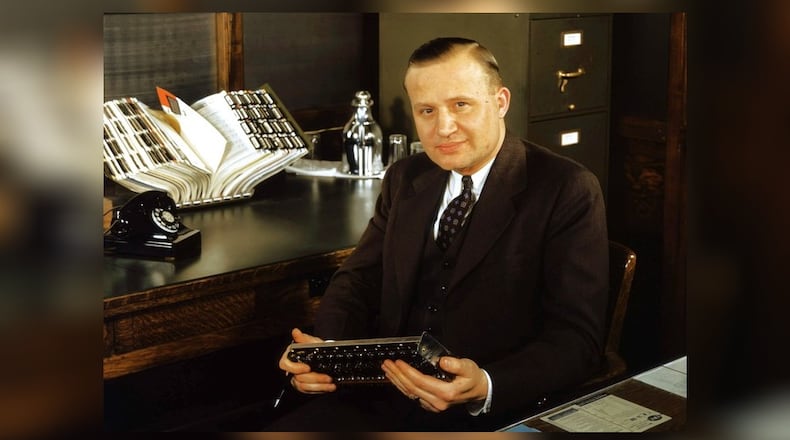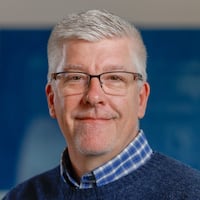Then Desch eventually became famous for his groundbreaking work on U.S. Navy bombes — the machines that broke Nazi German four-rotor enigma naval codes and helped to bring an end to World War II.
Work at NCR
Colonel Edward A. Deeds hired Joseph Desch, an electrical engineer, in 1938 to be the head of NCR’s Electrical Research Laboratory.
Desch worked as director of the NCR Electrical Research Department, and alongside Robert Mumma, he built the electronic accumulator in 1938. Believed to be the world’s first vacuum-tube-driven computing device, the electronic accumulator primed the world for first-generation computers.
In 1940, the National Defense Research Committee asked NCR to develop electronic defense equipment.
The Enigma
The World War II M4 Enigma cipher machine, used by the Germans to encode secret messages, was a huge problem for the Allies.
The cipher machine, designed with three rotors, was used by the Germans to encrypt communications to U-boats in the Atlantic Ocean. Thousands of ships in U.S. and Allied convoys were sunk because of plans made with these messages.
Credit: Axel Heimken
Credit: Axel Heimken
The British developed a machine called a Bombe that was able to decode the messages, but their machines were rendered virtually useless against U-boat messages when the Germans developed a fourth rotor for their naval Enigma machines.
That’s where Dayton and Desch came in.
Breaking the code
In 1942 and 1943, Desch headed a top-secret program at National Cash Register to develop an American version of the code-breaking Bombe that could break the four-rotor Enigma machine.
One reason Desch was selected was because of his and NCR’s work on inventing the first electronic calculator.
Desch worked with naval engineers on an advanced version of Polish and British code-breaking machines.
Alan Turing, an English computer scientist and mathematician who developed the British code breaking machine, visited Dayton on Dec. 21, 1942 to see the work being done at NCR.
For security reasons, Turing stayed at Desch’s home in Oakwood, which was guarded by armed Marines.
The two men argued about complex design components, and Turing criticized some of Desch’s work. Desch, however, stuck with what he was trying to do and ultimately became successful.
Desch’s code-breaking computer was six times faster than its British counterpart.
Desch’s daughter, Debbie Desch Anderson, often talked about the meeting of the two men.
“I’ve always been fascinated by the juxtaposition of their personalities. Turing was so polished and so used to British high society, and here he was meeting Joe Desch who grew up on the West Side of Dayton and was largely self-educated,” Anderson once told the Dayton Daily News.
Jim DeBrosse, a former Dayton Daily News reporter, co-wrote the book “The Secret in Building 26” about the work done at NCR to crack of the U-boat Enigma Codes.
“For a single scrambled letter, there were more possible settings for the Engima machine than there are atoms in the known universe,” he once told the Dayton Daily News. “Desch’s Bombe was the equivalent to 16 Engima machines working at high speed in reverse.”
The messages revealed the locations of the submarines, allowing them to be destroyed before they could attack allied ships.
Hundreds of Navy WAVES (Women Accepted for Volunteer Emergency Service) worked in Dayton during World War II assembling the top-secret machines. Each Bombe rolled on wheels, weighed two tons and measured 2 feet wide, 7 feet tall and 10 feet long.
The women stayed at Sugar Camp (a NCR sales training site) and worked on the secret WWII research project in NCR’s Building 26, located at the corner of Stewart Street and Patterson Boulevard.
NCR sent the machines to Navy headquarters in Washington, D.C, where the WAVES helped decode secret German communications.
The bombe was so successful it is thought to have saved thousands of lives.
After the war
In 1947, President Harry Truman awarded Desch the Medal for Merit, the highest U.S. civilian decoration, for his wartime work.
Credit: Ty Greenlees
Credit: Ty Greenlees
Desch was inducted to the Dayton Walk of Fame in 2001.
Building 26, located on the UD campus, was gutted in 2007 and torn down in 2008.
Debbie Desch Anderson and other preservationists opposed the demolition, but the state’s historic preservation board found the building to be ineligible for the National Register of Historic Places.
UD bought the land in a 50-acre purchase from NCR Corp. in 2005 for expanding its campus.
This month, Oakwood Mayor Bill Duncan and city council proclaimed May as “Codebreaker Month” to honor Desch, an Oakwood resident and pioneering engineer and inventor, for his invaluable contributions to the field of cryptography, which significantly hastened the Allied victory in World War II.
“His legacy inspires us to advance science, technology and global cooperation for the greater good of humanity,” Duncan said.
Desch died in 1987 at 80.
About the Author







